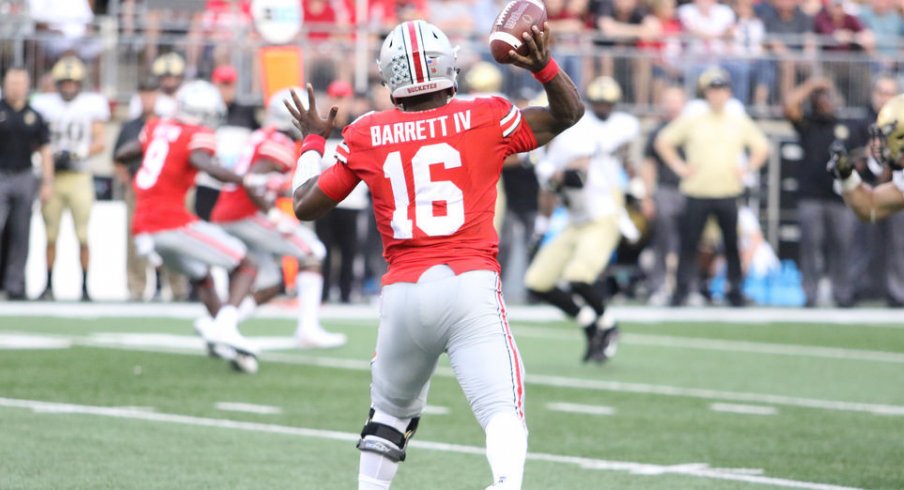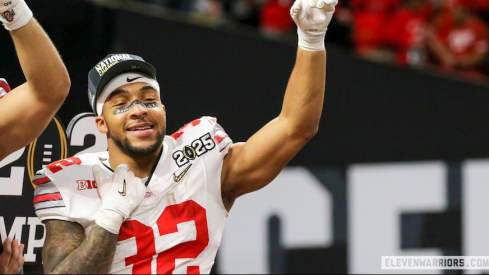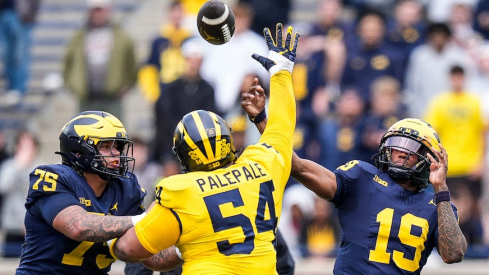"I think it is perfect because we have guys like K.J. (Hill) and Parris (Campbell) in the slot who can really make the first guy miss." - Ohio State wide receiver Terry McLaurin.
One needn't have watched all three of Ohio State's first three contests all that closely to recognize that the third was quite different from the first two. Sure, the cadets from West Point ran a unique, option-oriented offense full of pitches to the outside, but the Buckeyes' certainly seemed focused on getting the ball to the edges when they had the ball as well.
Though virtually every aspect of Urban Meyer's offense was criticized last week (except for his ability to recruit running backs), the home team in the Horseshoe came out with aggression on their opening drive, stressing the perimeter on every single play. Of course, that eight-play, 75-yard drive included five runs between the tackles and was capped by a J.T. Barrett trot into the end zone, but the plan had been clearly laid by the OSU coaching staff for all to see as the young receiving corps in scarlet and gray was about to have a big day.
After repeatedly running into a stacked box the week prior against Oklahoma, Meyer entrusted coordinator Kevin Wilson and QB coach Ryan Day to stretch the defense with Run-Pass Options (RPOs), which often came as simple 'relief' routes outside added to the existing run concepts already installed in the playbook. Every single play on the opening drive was an RPO of some sort, and the result was an offense that moved the ball at will.
Much like the triple option we saw from Army all afternoon, there is no pre-determined path for the football on these plays, as Barrett often had three places to send it. If the first defender he read stayed home, then the ball was handed off since the Buckeyes would have a numerical blocking advantage. If that defender attacks the run, Barrett then has the option to run outside or throw a bubble screen to the slot receiver.
Those slot receivers, Parris Campbell and K.J. Hill, would be busy catching screens all day long, hauling in 14 balls for 128 yards. While neither had seemed to find much rhythm catching the football downfield in the first two games of 2017, this catch-and-run mentality is perfectly suited to their skill sets as athletes that can make tacklers miss in the open field.
The best way to set up a bubble screen is with three receivers to the same side, meaning this Bubble-Screen RPO can become predictable, especially when the back is to that same side of the quarterback. If that's the case, then the defense can easily roll to one side and get enough bodies in both places. But Wilson was ready, sending jet-motion from even formations and not allowing the defense to get the needed numbers outside.
Wilson also began calling bubble screens with only one blocker for the receiver, and then flipped the whole thing around and began running the RPO to the weak side of the formation, always zigging as soon as the defense zagged.
There were other reliefs besides screens as well, as Barrett began reading the inside linebackers to determine when to handoff on an outside speed sweep, knowing a slant was coming right behind to fill the newly vacated space. While the run concept, Bash, has long been a favorite of Meyer's, Wilson had packaged a backside slant with perimeter runs while at Indiana, showing the influence he's having on the scheme in Columbus.
But this new focus in the play-calling isn't indicative of a new philosophy for Meyer's offense; far from it. All the work attacking the edges was done so the Buckeyes could become the physical, running team the coach has always craved.
"What makes the inside run game open up is when you start hitting all those bubble screens and a lot of the horizontal pass plays," Meyer said after the game. "(If you don't) eventually they just get in tighter and tighter."
As the clips above show, J.K. Dobbins was the true beneficiary of this new strategy. After the freshman phenom made a statement early in the second half last week, the Sooners made a conscious decision to stay home on any option plays - forcing Barrett to keep for himself instead of putting the ball in the talented youngster's hands.
This week, though, Meyer seemed determined to keep the drunken masses yelling about his reliance on the QB run at bay, setting up his running back to hit the knockout punch after establishing the jab with his receivers. Though Dobbins is an exceptional talent, able to both run through arm tackles or make a defender miss completely and look silly, he often didn't see contact until he was already five yards downfield, largely the result of a defense more worried about stopping the short perimeter throws than his running prowess.
With the Army defense dazed, Barrett was then able to take shots downfield. On the possession following Dobbins' 52-yard touchdown run to open the second half, the Buckeyes used play-action and the bubble screen action to set up a big play behind a cheating safety.
Two plays later, the Buckeyes would once again catch the Black Knights focusing on a potential screen, allowing McLaurin to catch an easy, 20-yard touchdown pass.
This doesn't mean the Buckeye offense was perfect. Barrett again missed some open throws downfield, the perimeter blocking saw far too many penalty flags, and the offense seemed to stall whenever Wilson called something other than an RPO on first down.
But Buckeye fans should be encouraged by this performance, not just because the offense tallied 270 yards on the ground and 316 through the air, but because of HOW they did so. While Meyer has always looked to stress the edge defender in hopes of opening up the inside running game, his offenses have been most potent when they also stressed the alley defenders.
In 2014, the Buckeyes were able to get over the hump against Michigan State's vaunted 'Quarters' defense because of how they attacked the safeties and outside linebackers, both with sweeps and screens underneath and deep passes over the top. The Spartans became so worried about allowing big plays on the perimeter that they could no longer be aggressive in run support, leading to 154 yards on the ground from Ezekiel Elliott with another 86 coming from Barrett that night in East Lansing.
While many may wonder if another Devin Smith-type deep threat will emerge, the offensive brain trust seems focused on building the offense in a way that doesn't depend on the deep play-action passing game as it once did, and that's not a bad thing. Instead of forcing the pieces to fit a different puzzle, the Meyer, Wilson, and Day are looking for the best ways to use the talent at hand, including a quarterback best suited to be a point guard-like distributor and some shifty receivers that can shake a defender or two.
"I thought Kevin Wilson and Ryan Day did a nice job mixing and matching," Meyer said Saturday. "It's all how you play, how they're playing – if they're starting to pack it in there, you get outside."
The Buckeyes got outside plenty against Army, and the results speak for themselves.



